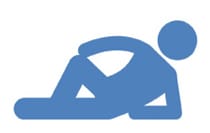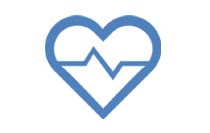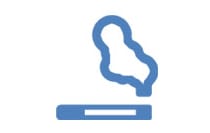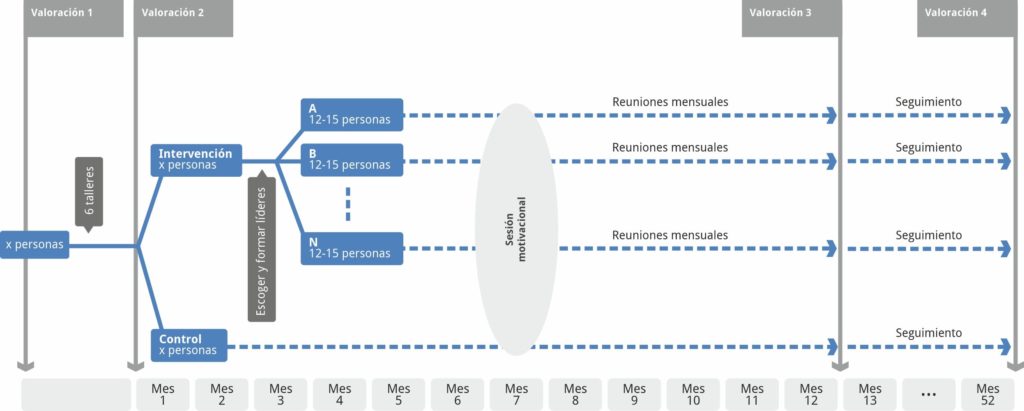“if adults are trained in peer groups and provided with the knowledge, skills and attitudes a healthy lifestyle requires, their cardiovascular health habits and their own self-control of the risk factors will improve”
DR. VALENTÍN FUSTER
“if adults are trained in peer groups and provided with the knowledge, skills and attitudes a healthy lifestyle requires, their cardiovascular health habits and their own self-control of the risk factors will improve”
DR. VALENTÍN FUSTER
FIFTY-FIFTY Programa
Hypothesis
If adults are trained in peer groups and provided with the knowledge, skills and attitudes a healthy lifestyle requires, their cardiovascular health habits and their own self-control of the risk factors will improve.
In Spain, cardiovascular diseases are the leading cause of mortality or disability [1].
The American Heart Association defines that cardiovascular health is poor in Spain (1). Less than 1% of all Spaniards reach ideal values for the 7 cardiovascular health indicators and thus have a healthy lifestyle [3]. In Spain the prevalence in adults of overweight is: 36%, obesity: 17%, smoking: 27% and sedentary life: 37%.

Sedentary lifestyle

Unhealthy eating

Blood Pressure

Overweight

Smoking
Figure 1. Cardiovascular risk factors.
The SHE Foundation and the Spanish Agency of Consumer Affairs, Food Security and Nutrition (AESAN) from the Spanish Ministry of Consumer Affairs, promoted the introduction of the Fifty-Fifty Program. This Program constitutes a community intervention trial designed by Dr. Valentín Fuster with the aim of improving comprehensive health in adults, helping them to establish self-control of the main risk factors for such diseases. The participants in the study were healthy adults between 25-50 years of age and with at least one cardiovascular risk factor.
Based on previous scientific learnings, Dr. Fuster initiated a pilot project in the town of Cardona (Barcelona, Spain). The good results obtained facilitated the conduction of a larger study in another 7 Spanish cities and towns: Barcelona, Cambrils, Guadix, Manresa, Molina de Segura, San Fernando de Henares and Villanueva de la Cañada (Figure 2). This study involved 543 volunteers (71% females), each with at least one cardiovascular risk factor.
The intervention was based on elements of Social Cognitive Theory [4]. The key elements of this theory include observational learning, reinforcement, self-control and self-efficacy.

Figure 2. Fifty-Fifty Program: Cities and towns participating in the scientific study.
In a first phase, all the participants were enrolled in educational and motivational workshops designed to promote healthy living habits. The meetings were used to address motivations for change, stress management, smoking cessation, healthy eating habits, regular physical exercise, and blood pressure self-control.
Figure 3. Intervention of the Fifty-Fifty Program.
Then, in a second phase lasting 12 months, the participants were randomized to two groups (1:1): an intervention group, involving peer group activities; and a control group, simply subjected to follow-up during the same period of time (5) (Figure 4).
Figure 4. Fifty-Fifty Program scientific study design.
The investigators have performed a new analysis of cardiovascular risk factors: at baseline, after workshops, 12 months (after peer group) and 40 months after the end of the study to assess the progression of the participants.
The main outcome assessed in the study was the mean change in a composite score related to blood pressure, exercise, weight, diet and tobacco consumption (Fuster-BEWAT score).
The results obtained from the study, accompanied by a rigorous scientific evaluation [6,7], confirm that educating adults in knowledge, skills and attitudes about a healthy lifestyle, accompanied by peer support, improves cardiovascular health habits and self-management of risk factors, and confirms the importance of giving continuity to support dynamics [8].
The Fifty-Fifty Program has also been applied in Spanish companies PortAventura and AMPO with the aim of providing tools to improve the cardiovascular health of their workers.
It is essential to implement programs to promote healthy habits which, like this one, are of great value in raising public awareness, since, in the words of Dr. Fuster, “we must not prevent disease, we must promote health”.
References
- Banegas JR et al. Rev Esp Cardiol Supl, 2006, 6(G):3-12. Epidemiología de las enfermedades cardiovasculares en España.
- Lloyd-Jones DM et al. Circulation, 2010, 121(4):586-613. Defining and setting national goals for cardiovascular health promotion and disease reduction: the American Heart Association’s strategic Impact Goal through 2020 and beyond.
- Graciani A et al. Circ Cardiovasc Qual Outcomes, 2013, 6(1):90-8. Cardiovascular health in a southern Mediterranean European country: a nationwide population-based study.
- Glanz K and Bishop DB. Annu Rev Public Health, 2010, 31:399-418. The role of behavioral science theory in development and implementation of public health interventions.
- Karwalajtys T et al. J Community Health, 2009, 34(4):336-45. Development of the volunteer peer educator role in a community Cardiovascular Health Awareness Program (CHAP): a process evaluation in two communities.
- Thompson PD et al. Circulation, 2007, 115(17):2358-68. Exercise and acute cardiovascular events placing the risks into perspective: a scientific statement from the American Heart Association Council on Nutrition, Physical Activity, and Metabolism and the Council on Clinical Cardiology.
- Heath GW et al. Lancet, 2012, 380(9838):272-81. Evidence-based intervention in physical activity: lessons from around the world.
- Fernández-Alvira JM, Fuster V et al. Am Heart J, 2021, 240:81-88. The challenge of sustainability: Long-term results from the Fifty-Fifty peer group-based intervention in cardiovascular risk factors.
All rights reserved. The total or partial reproduction of this work is not allowed. You may not copy, reproduce, distribute, publish, display, perform, modify, create derivative works, transmit, or in any way exploit any such content, nor may you distribute any part of this content over any network, including a local area network, sell or offer it for sale, or use such content to construct any kind of database without prior written authorization from the owners of the work copyright. The infringement of said rights may constitute a crime against intellectual property.


